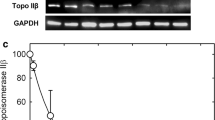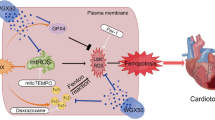Abstract
The clinically approved antioxidant cardioprotective agent dexrazoxane (ICRF-187) was examined for its ability to protect neonatal rat cardiac myocytes from doxorubicin-induced damage. Doxorubicin is thought to induce oxidative stress on the heart muscle, both through reductive activation to its semiquinone form, and by the production of hydroxyl radicals mediated by its complex with iron. Hydrolyzed dexrazoxane metabolites prevent site-specific iron-based oxygen radical damage by displacing iron from doxorubicin and chelating free and loosely bound iron. The mitochondrial stain Mito Tracker Green GM and doxorubicin were shown by epifluorescence microscopy to accumulate in the myocyte mitochondria. An epifluorescence microscopic image analysis method to measure mitochondrial damage was developed using the mitochondrial membrane potential sensing ratiometric dye JC-1. This method was used to show that dexrazoxane protected against doxorubicin-induced depolarization of the myocyte mitochondrial membrane. Dexrazoxane also attenuated doxorubichin-induced oxidation of intracellular dichlorofluorescin. Annexin V-FITC/propidium iodide staining of myocytes was used to demonstrate that, depending on the concentration, doxorubicin caused both apoptotic and necrotic damage. These results suggest that doxorubicin may be cardiotoxic by damaging the mitochondria and dexrazoxane may be protective by preventing iron-based oxidative damage.
Similar content being viewed by others
References
Hasinoff, B. B., Hellmann, K., Herman, E. H., and Ferrans, V. J. (1998). Chemical biological and clinical aspects of dexrazoxane and other bisdioxopiperazines. Curr. Med. Chem. 5:1–28.
Malisza, K. L. and Hasinoff, B. B. (1995). Production of hydroxyl radical by iron(III)-anthraquinone complexes through self-reduction and through reductive activation by the xanthine oxidase/hypoxanthine systems. Arch. Biochem. Biophys. 321:51–60.
Barnabé, N., Zastre, J., Venkataram, S. and Hasinoff, B. B. (2002). Deferiprone protects against doxorubicin-induced myocyte cytotoxicity. Free Radic. Biol. Med. 33:266–275.
Hasinoff, B. B. (1994). Pharmacodynamics of the hydrolysis-activation of the cardioprotective agent (+)-1,2-bis(3,5-dioxopiperazinlyl-l-yl)propane. J. Pharm. Sci. 83:64–67.
Hasinoff, B. B. (1994). An HPLC and spectrophotometric study of the hydrolysis of ICRF-187 (dexrazoxane, (+)-1,2-bis(3,5-dioxopiperazinyl-l-yl)propane) and its onering opened intermediates. Int. J. Pharmacol. 107:67–76.
Diop, N. K., Vitellaro, L. K., Arnold, P., Shang, M., and Marusak, R. A. (2000). Iron complexes of the cardioprotective agent dexrazoxane (ICRF-187) and its desmethyl derivative, ICRF-154: solid state structure, solution thermodynamics, and DNA cleavage activity. J. Inorg. Biochem. 78:209–216.
Huang, Z.-X., May, P. M., Quinlan, K. M., Williams, D. R., and Creighton, A. M. (1982). Metal binding by pharmaceuticals. Part 2. Interactions of Ca(II), Cu(II), Fe(II), Mg(II), Mn(II) and Zn(II) with the intracellular hydrolysis products of the antitumor agent ICRF-159 and its inactive homologue ICRF-192. Agents Actions 12:536–542.
Buss, J. L. and Hasinoff, B. B. (1993). The one-ring open hydrolysis product intermediates of the cardioprotective agent ICRF-187 (dexrazoxane) displace iron from ironanthracycline complexes. Agents Actions 40:86–95.
Dawson, K. M. (1975). Studies on the stability and cellular distribution of dioxopiperazines in cultured BHK-21S cells. Biochem. Pharmacol. 24:2249–2253.
Jung, K. and Reszka, R. (2001). Mitochondria as subcellular targets for clinically useful anthracyclines. Adv. Drug Deliv. Rev. 49:87–105.
Hershko, C., Pinson, A., and Link, G. (1996). Prevention of anthracycline cardiotoxicity by iron chelation. Acta Haematol. 95:87–92.
Sokolove, P. M. and Shinaberry, R. G. (1988). Na+-independent release of Ca2+ from rat heart mitochondria. Biochem. Pharmacol. 37:803–812.
Gianni, L., Corden, B. J. and Myers, C. E. (1983). The biochemical basis of anthracycline toxicity and anti-tumor activity. Rev. Biochem. Toxicol. 5:1–82.
Hasinoff, B. B. and Davey, J. P. (1988). Adriamycin and its iron(III) and copper(II) complexes; glutathione-induced dissociation; cytochrome c oxidase inactivation and protection; binding to cardiolipin. Biochem. Pharmacol. 37: 3663–3669.
Goormaghtigh, E., Huart, P., Praet, M., Brasseur, R., and Ruysschaert, J.-M. (1990). Structure of the adriamycincardiolipin complex. Role in mitochondrial toxicity. Biophys. Chem. 35:247–257.
Reers, M., Smiley, S. T., Mottolla-Hartshorn, C., Chen, A., Lin, M., and Chen, L. B. (1995). Mitochondrial membrane potential monitored by JC-1 dye. Methods Enzymol. 260: 406–417.
Keij, J. F., Bell-Prince, C., and Steinkamp, J. A. (2000). Staining of mitochondrial membranes with 10-nonyl acridine orange, MitoFluor Green, and Mito Tracker Green is affected by mitochondrial membrane potential altering drugs. Cytometry 39:203–210.
Swift, L. M. and Sarvazyan, N. (2000). Localization of dichlorofluorescin in cardiac myocytes: Implications for assessment of oxidative stress. Am. J. Physiol. Heart Circ. Physiol. 278:H982-H990.
Sarvazyan, N. (1996). Visualization of doxorubicin-induced oxidative stress in isolated cardiac myocytes. Am. J. Physiol. 271:H2079-H2085.
Link, G., Tirosh, R., Pinson, A., and Hershko, C. (1996). Role of iron in the potentiation of anthracycline cardiotoxicity: identification of heart cell mitochondria as a major site of iron-anthracycline interaction. J. Lab. Clin. Med. 127:272–278.
Childs, A. C., Phaneuf, S. L., Dirks, A. J., Phillips, T., and Leeuwenburgh, C. (2002). Doxorubicin treatment in vivo causes cytochrome c release and cardiomyocyte apoptosis, as well as increased mitochondrial efficiency, superoxide dismutase activity, and Bcl-2: Bax ratio. Cancer Res. 62: 4592–4598.
Kluck, R. M., Bossy-Wetzel, E., Green, D. R., and Newmeyer, D. D. (1997). The release of cytochrome c from mitochondria: A primary site for Bcl-2 regulation of apoptosis. Science 275:1132–1136.
Dunkern, T. R. and Mueller-Klieser, W. (1999). Quantification of apoptosis induction by doxorubicin in three types of human mammary carcinoma spheroids. Anticancer Res. 19:3141–3146.
Sawyer, D. B., Fukazawa, R., Arstall, M. A., and Kelly, R. A. (1999). Daunorubicin-induced apoptosis in rat cardiac myocytes is inhibited by dexrazoxane. Circ. Res. 84: 257–265.
Kumar, D., Kirshenbaum, L., Li, T., Danelisen, I., and Singal, P. (1999). Apoptosis in isolated adult cardiomyocytes exposed to adriamycin. Ann. N. Y. Acad. Sci. 874:156–168.
Kotamraju, S., Konorev, E. A., Joseph, J., and Kalyanaraman, B. (2000). Doxorubicin-induced apoptosis in endothelial cells and cardiomyocytes is ameliorated by nitrone spin traps and ebselen. Role of reactive oxygen and nitrogen species. J. Biol. Chem. 275:33585–33592.
Hasinoff, B. B. (2002). Dexrazoxane (ICRF-187) protects cardiac myocytes against hypoxia-reoxygenation damage. Cardiovasc. Toxicol. 2:111–118.
Malisza, K. L. and Hasinoff, B. B. (1996). Inhibition of anthracycline semiquinone formation by ICRF-187 (dexrazoxane) in cells. Free Radicals Biol. Med. 20:905–914.
LeBel, C. P., Ischiropoulos, H., and Bondy, S. C. (1992). Evaluation of the probe 2′,7′-dichlorofluorescin as an indicator of reactive oxygen species formation and oxidative stress. Chem. Res. Toxicol. 5:227–231.
Rota, C., Chignell, C. F., and Mason, R. P. (1999). Evidence for free radical formation during the oxidation of 2′-7′-dichlorofluorescin to the fluorescent dye 2′–7′-dichlorofluorescein by horseradish peroxidase: possible implications for oxidative stress measurements. Free Radicals Biol. Med. 27:873–881.
Kang, Y. J., Zhou, Z. X., Wang, G. W., Buridi, A., and Klein, J. B. (2000). Suppression by metallothionein of doxorubicin-induced cardiomyocyte apoptosis through inhibition of p38 mitogen-activated protein kinases. J. Biol. Chem. 275:13690–13698.
Davies, K. J. A. and Doroshow, J. H. (1986). Redox cycling of anthracyclines by cardiac mitochondria. I. Anthracycline radical formation by NADH dehydrogenases. J. Biol. Chem. 261:3060–3067.
Myers, C. E., Mimnaugh, E. G., Yeh, G. C., and Sinha, B. K. (1988). Biochemical mechanisms of tumor cell kill by the anthracyclines. In Lown, J. W. (ed.), Anthracycline and Anthracenedione-based Anticancer Agents, vol. 6. Amsterdam: Elsevier, pp. 527–569.
Hochster, H., Liebes, L., Wadler, S., Oratz, R., Wernz, J. C., Meyers, M., Green, M., Blum, R. H., and Speyer, J. L. (1992). Pharmacokinetics of the cardioprotector ADR-529 (ICRF-187) in escalating doses combined with fixed-dose doxorubicin. J. Natl. Cancer Inst. 84:1725–1730.
Zhang, J., Clark, J. R., Herman, E. H., and Ferrans, V. J. (1996). Doxorubicin-induced apoptosis in spontaneously hypertensive rats: Differential effects in heart, kidney and intestine, and inhibition by ICRF-187. J. Mol. Cell. Cardiol. 28:1931–1943.
Herman, E. H., Zhang, J., Hasinoff, B. B., Clark, J. R. J., and Ferrans, V. J. (1997). Comparison of the structural changes induced by doxorubicin and mitoxantrone in the heart, kidney and intestine and characterization of the Fe(III)-mitoxantrone complex. J. Mol. Cell. Cardiol. 29: 2415–2430.
Hasinoff, B. B. (1993). Enzymatic ring-opening reactions of the chiral cardioprotective agent (+) (S)-ICRF-187 and its (−) (R)-enantiomer ICRF-186 by dihydropyrimidine amidohydrolase. Drug Metab. Dispos. 21:883–888.
Schroeder, P. E., Davidson, J. N., and Hasinoff, B. B. (2002). Dihydroorotase catalyzes the ring-opening of the hydrolysis intermediates of the cardioprotective drug dexrazoxane (ICRF-187). Drug Metab. Dispos. 30:1431–1435.
Schroeder, P. E., and Hasinoff, B. B. (2002). The doxorubicin-cardioprotective drug dexrazoxane undergoes metabolism in the rat to its metal ion-chelating form ADR-925. Cancer Chemother. Pharmacol. 50:509–513.
Author information
Authors and Affiliations
Corresponding author
Rights and permissions
About this article
Cite this article
Hasinoff, B.B., Schnabl, K.L., Marusak, R.A. et al. Dexrazoxane (ICRF-187) protects cardiac myocytes against doxorubicin by preventing damage to mitochondria. Cardiovasc Toxicol 3, 89–99 (2003). https://doi.org/10.1385/CT:3:2:89
Issue Date:
DOI: https://doi.org/10.1385/CT:3:2:89




